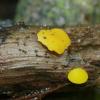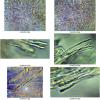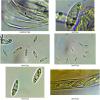
03-06-2017 23:07
 Bernard CLESSE
Bernard CLESSE
J'ai trouvé cet asco jaune sur branche pourrie da

03-06-2017 19:25
 Bernard CLESSE
Bernard CLESSE
Bonsoir à tous et toutes,Voici un asco trouvé su

30-05-2017 20:17
Found on wet, sandy soil, mixed with rotting plant

31-05-2017 21:13
 Rubén Martínez-Gil
Rubén Martínez-Gil
Hola a todos. Una amiga me envía estas fotos de

27-12-2016 14:02
Dragiša SavicHi, I would say that this is (in accordance with R

15-12-2014 10:28
Garcia SusanaHi allI found this ascomycete on a sprig of Pinus

30-05-2017 23:54
Valencia Lopez Francisco JavierHola a todosEsta Peziza crecía en la orilla de un

31-05-2017 04:47
Ethan CrensonIn New York City, Inwood Hill Park (Upper Manhatta
Asco jaune sur branche pourrie dans une zone de suintement
Bernard CLESSE,
03-06-2017 23:07
 J'ai trouvé cet asco jaune sur branche pourrie dans une zone de suintement :
J'ai trouvé cet asco jaune sur branche pourrie dans une zone de suintement :a) excipulum à textura intricata
b) paraphyses filiformes, à contenu réfringent
c) asques IKI-
d) spores fusiformes, guttulées : 11-15,5x3,5-5
Bernard




